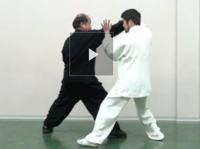Chinese Class
What does it mean to get something into the body? You are able to do it without thinking about it, e.g. when you can complete a yilu talking to someone, this means the yilu movements become automatic, while your attention is in talking to that person.
Three solid spots in the circle
1st Example: When in-with-elbow is completed, the elbow gets to a place where it can’t move anymore, and we keep the elbow there. We turn the waist until the waist can’t move anymore, and we keep the waist there. We can do out with hand until the the hand can’t go out anymore, and we keep the hand there.
2nd Example: Back, Front (Hand), Bottom (Elbow) – This leads eventually to Ba Mian Zhi Cheng (supported in 8 directions).
Cross Hands (Shi Zi Shou) – The crossed hands should be just above dantian. Don’t turn the body.
Lean with Back (Bei Zhe Kao) – Stretch the right elbow to the left without dropping the right fist, keep stretch around to bring the right elbo to the right side slightly above the right shoulder. At this point, the left elbow should be pointing at the front (camera) with the left hand tucked at the left waist. Create a stretch between the right elbow and left foot. Don’t turn too much or we will be over the point of maximum stretch.
Change Palms Three Times (San Huan Zhang) – The first 2 counts are to get the arms through a tube. We rotate to the right to bring the two forearms together (stack left forearm on top of the right forearm). We are folding the left side to the right side (Don’t move the right hand during the fold).
Rotate (Zhuan) – Don’t move the inside, use the outside to cause the rotation. This is separation of yin and yang.
Buddha’s Warror Pound Mortar (Jin Gang Dao Dui) – 1st count: We must have a rod between Bai Hui and Hui Yin. That rod cannot toss. As an example, we can use the left ankle to cause the rod to rotate to the right.
English Class
After Lean with Back (Bei Zhe Kao) – Rotate the central axis with to bring the elbow to the front of the chest. Keep the boomerange at the arm. Rotate the opposite direction to get the left hand over the right elbow.
We have to speak the taiji language. We have to learn that language. We must watch and watch, we can’t make things up (but that’s what we do). One day we see it, it will change us. It’s like “OMG, it’s actually like this, why didn’t I see it before?”.
Gou Da Mao Niang (狗打猫娘)- It’s the Chinese way to mimic the sound of “Good Morning”. It is not English, but it is English to the Chinese people. We can’t mimic taiji with what we already know, we must copy Master Chen.
Shakespeare does not write English like anyone else. Master Chen does not move like others, but others think that they move like him.
All the movements come out of rotation. We have to learn to see that in Master Chen’s movements.
http://practicalmethod.com/2020/10/chen-zhonghuas-online-lesson-20201008-online-video-purchase/


